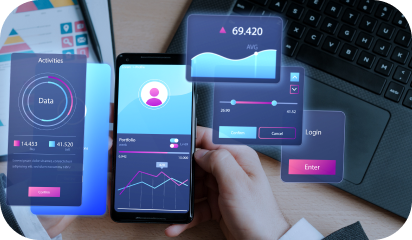Mobile devices are an integral part of our lives. They are used to cater to different needs of the users, including business and social networking, banking, entertainment, and even grocery shopping. Mobile apps are a great way to improve your product or service and reach out to more users. One of the key differences between a successful mobile app and the one that fails are the design elements – user experience (UX) and user interface (UI). UI is the components and the layout of the mobile app with which the users can interact, whereas UX is the overall experience of the user using the app.
The UI/UX design is one of the most important factors to consider while building a mobile app. Having said that, the global trends in UX design and UI design are constantly changing and it may seem like a challenge to keep up with the latest trends. In this article, we have compiled some of the key mobile app design considerations.
Keeping the app simple
Mobile devices are short in real estate, and hence knowing what are the most important elements of your offering is crucial for a successful mobile design. Keeping the app layout simple ensures easy navigation and a great user experience. It is very important that the app navigation is easier, faster, and smoother to use. Having unnecessary features in the app reduces the app speed and leads to a poor user experience.
However, simplicity does not mean minimalistic design. The design should be creative and such that the users complete their tasks in as few steps as possible. Unnecessary steps will likely leave your user frustrated and unhappy with their experience.
Finger-friendly design
With mobile devices, we use our fingers to navigate through the app. Hence, having a finger-friendly design is a crucial consideration while designing your app to understand how your users will interact within the app. Over time, users have been familiarized with certain finger movements and these have become standard use for tasks such as swiping to go to the next page, double tap and pinch to zoom, etc. Additionally button design plays an important role in designing the app. These buttons should be adequately sized and should be located at the right places on the screen. Excessive scrolling inside an app can be frustrating and lead to a bad user experience.
Responsiveness
Mobile devices have a very wide range of sizes and your app should be able to respond to these. Additionally, each device have two different screen modes in which the devices can be viewed — landscape and portrait mode. App designers should design the app such that important elements respond to different screen sizes and orientations and are displayed appropriately. Hence, mobile responsiveness has become an integral part of the app front end development.
Consistency of design
Maintaining consistency across your app provides familiarity and ease of use for the end user. A good practice is to define your elements and then repeat them throughout the app. These elements include but are not limited to style, color, fonts, buttons, etc. A consistent app design ensures a rich user experience. On the other hand, a non-consistent hampers your app’s intuition and will mostly frustrate the user leading to a poor user experience.
Conclusion
Mobile apps are increasingly becoming part of our daily life and the focus of good developers remains to keep the user happy. Keeping the basic mobile app design considerations in mind ensures that the focus remains on the user. If you’ve any doubts related to mobile app development and if you need assistance developing one, then feel free to talk to us here.

